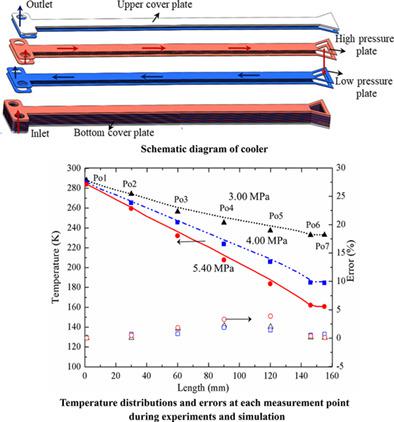当前位置:
X-MOL 学术
›
Int. J. Energy Res.
›
论文详情
Our official English website, www.x-mol.net, welcomes your
feedback! (Note: you will need to create a separate account there.)
Experimental and numerical analysis of the multilayer distributed Joule‐Thomson cooler with pillars
International Journal of Energy Research ( IF 4.3 ) Pub Date : 2020-12-01 , DOI: 10.1002/er.6230 Hui Geng 1, 2 , Xiaoyu Cui 1, 2 , Hailong She 1, 2 , Zhihao Chang 1, 2
International Journal of Energy Research ( IF 4.3 ) Pub Date : 2020-12-01 , DOI: 10.1002/er.6230 Hui Geng 1, 2 , Xiaoyu Cui 1, 2 , Hailong She 1, 2 , Zhihao Chang 1, 2
Affiliation

|
The conventional Joule‐Thomson cooler is not compact in heat exchanger and insufficient in cooling capacity, which is limited in applying integrated electronics. However, microchannels with pillars are effective in increasing the area to volume ratio and enhancing heat transfer through the presence of vortex. Besides, multilayer microchannels are essential to enlarge the mass‐flow rate in the cooler. In this study, a multilayer distributed J‐T cooler with pillars is investigated. A new mathematical model of the cooler is developed and validated against the experimental data; the relative errors of the temperature and mass‐flow rate are both within 5%. Furthermore, the distribution of temperature and pressure in the microchannel is analyzed by the model calculation. Numerical results show that the temperature of the high‐pressure fluid decreased slightly under the influence of the heat exchange and distributed J‐T effect. When the inlet pressures are 3.00, 4.00 and 5.40 MPa, the cold‐end temperatures are 233.0, 185.8 and 161.2 K, respectively, with the cooling capacity reaching 2.25, 3.40 and 3.87 W, respectively. In addition, the influences of the axial heat conduction and heat leakage on the cooling performance are analyzed by using the models. The temperature rise of the cold end increases by 6.8 and 6.2 K at 5.40 MPa, respectively, considering the above two factors. The simulation model provides a useful tool for the J‐T cooler.
中文翻译:

带支柱的多层分布式焦耳-汤姆逊冷却器的实验和数值分析
常规的焦耳-汤姆逊冷却器在热交换器中不紧凑,并且冷却能力不足,这在应用集成电子设备时受到限制。然而,具有支柱的微通道可有效地增加面积与体积之比,并通过涡旋的存在增强传热。此外,多层微通道对于扩大冷却器的质量流量至关重要。在本研究中,研究了带有支柱的多层分布式J‐T冷却器。开发了冷却器的新数学模型,并根据实验数据进行了验证;温度和质量流量的相对误差均在5%以内。此外,通过模型计算来分析微通道中的温度和压力的分布。数值结果表明,在热交换和分布J-T效应的影响下,高压流体的温度略有下降。当入口压力为3.00、4.00和5.40 MPa时,冷端温度分别为233.0、185.8和161.2 K,冷却能力分别达到2.25、3.40和3.87W。此外,通过使用模型分析了轴向热传导和热泄漏对冷却性能的影响。考虑到以上两个因素,冷端的温度升高在5.40 MPa时分别增加6.8和6.2K。仿真模型为J‐T冷却器提供了有用的工具。分别为2 K,冷却能力分别达到2.25、3.40和3.87W。此外,通过使用模型分析了轴向热传导和热泄漏对冷却性能的影响。考虑到以上两个因素,冷端的温度升高在5.40 MPa时分别增加6.8和6.2K。仿真模型为J‐T冷却器提供了有用的工具。分别为2 K,冷却能力分别达到2.25、3.40和3.87W。此外,通过使用模型分析了轴向热传导和热泄漏对冷却性能的影响。考虑到上述两个因素,冷端的温度上升在5.40 MPa时分别增加6.8和6.2K。仿真模型为J‐T冷却器提供了有用的工具。
更新日期:2020-12-01
中文翻译:

带支柱的多层分布式焦耳-汤姆逊冷却器的实验和数值分析
常规的焦耳-汤姆逊冷却器在热交换器中不紧凑,并且冷却能力不足,这在应用集成电子设备时受到限制。然而,具有支柱的微通道可有效地增加面积与体积之比,并通过涡旋的存在增强传热。此外,多层微通道对于扩大冷却器的质量流量至关重要。在本研究中,研究了带有支柱的多层分布式J‐T冷却器。开发了冷却器的新数学模型,并根据实验数据进行了验证;温度和质量流量的相对误差均在5%以内。此外,通过模型计算来分析微通道中的温度和压力的分布。数值结果表明,在热交换和分布J-T效应的影响下,高压流体的温度略有下降。当入口压力为3.00、4.00和5.40 MPa时,冷端温度分别为233.0、185.8和161.2 K,冷却能力分别达到2.25、3.40和3.87W。此外,通过使用模型分析了轴向热传导和热泄漏对冷却性能的影响。考虑到以上两个因素,冷端的温度升高在5.40 MPa时分别增加6.8和6.2K。仿真模型为J‐T冷却器提供了有用的工具。分别为2 K,冷却能力分别达到2.25、3.40和3.87W。此外,通过使用模型分析了轴向热传导和热泄漏对冷却性能的影响。考虑到以上两个因素,冷端的温度升高在5.40 MPa时分别增加6.8和6.2K。仿真模型为J‐T冷却器提供了有用的工具。分别为2 K,冷却能力分别达到2.25、3.40和3.87W。此外,通过使用模型分析了轴向热传导和热泄漏对冷却性能的影响。考虑到上述两个因素,冷端的温度上升在5.40 MPa时分别增加6.8和6.2K。仿真模型为J‐T冷却器提供了有用的工具。











































 京公网安备 11010802027423号
京公网安备 11010802027423号